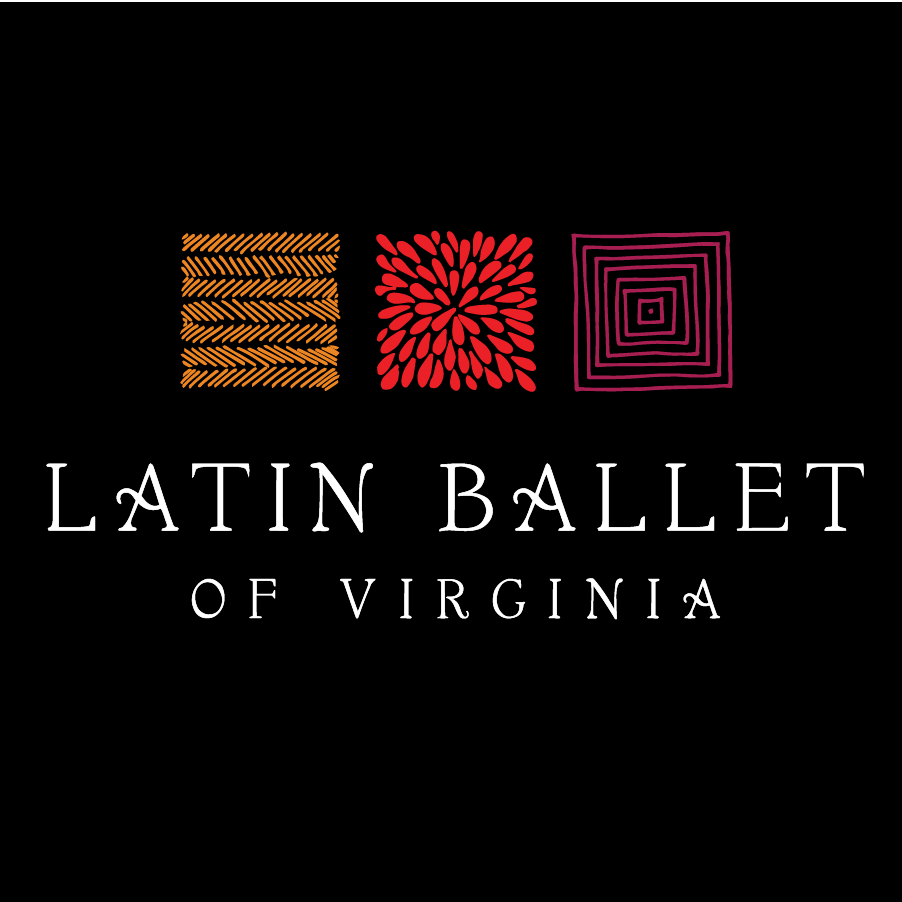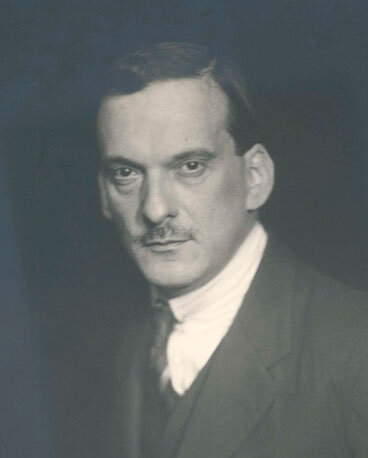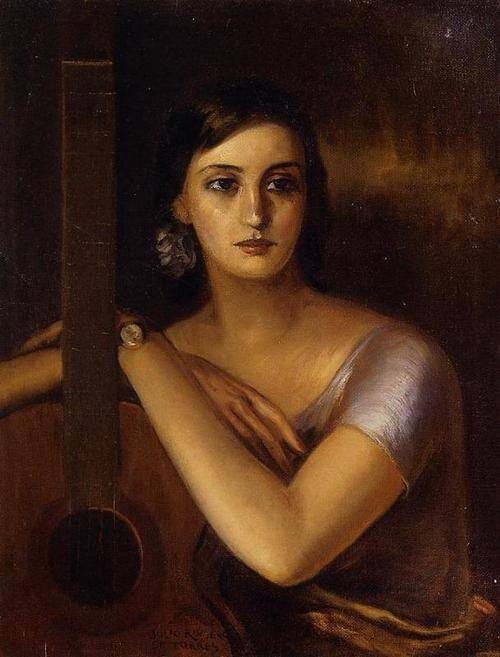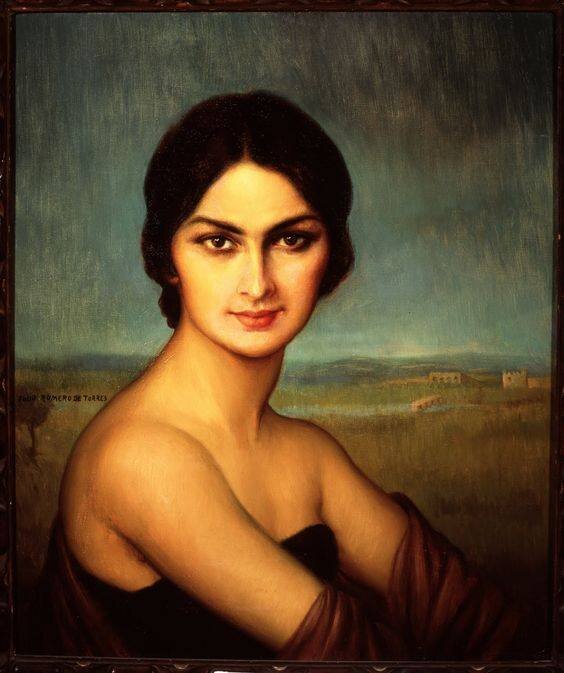El Pintor: Study Guide
The Latin Ballet of Virginia presents the world premier of EL PINTOR, Profile of Spanish Women, Sponsored in part by the Carpenter Foundation, An original flamenco dance theatre based on the exceptional art of Spanish artist Julio Romero de Torres.
Alegrías de Julio Romero de Torres
Julio Romero de Torres
EL PINTOR (The Painter) is based on the philosophical views of famous painter Julio Romero de Torres from Córdoba, Spain, who dedicated his life to reflect the traditions of southern Spain, expressing in his painting the state of the times at the end of the first Spanish republic.
El Pintor focuses his art on the Spanish women from different social classes and the way they were allowed to express themselves. He uses many landscapes of his native Cordoba and the culture of his time. Most of his art is closely related to the magical spectrum of flamenco, the Spanish traditional dance form and most important part of Spanish culture. His art pays homage to the greatest artists of the time: singers, dancers and musicians as a symbol of eternal love of flamenco and Andalucian region, a land of nostalgia, fire and joy. Julio Romero de Torres, the extraordinary artist whose art is as "deep" as the deep song he loved, Cante Jondo (Deep Song).
Julio Romero de Torres, the son of Rafael Romero Barros was famous for his paintings of women’s profiles. He will be always remembered for painting “La Mujer Morena”, (The brunette woman, mystery in her eyes, torment in her soul), like the words of the famous Spanish folk song, but he contributed so much more than this to the art world. From 1922 to the day he became very ill, his activity was intense.
He painted about 220 pieces of art-work, all of them admirable like his biblical women: Salome, Judith, Martha, Maria, Ruth and Noemi. Some of his most important art work include: Sacred and Profane Love, The Poem of Cordoba, The Blessing of the Song, Carmen and the Little Coal Girl, as well as, the Saeta, Malaguenas and Deep Song.
Julio Romero’s inspiration for his work was the true and deep emotional soul of the women of his time. “Because the eyes are blind, it is necessary to look deep into the heart”, and while searching for it, El Pintor created a new form of expression, a literary concept of the imminent Renaissance art, in a perfect balance between mysticism, sensuality and melancholy, having always as scenery, the enigmatic and eternal Córdoba.
La Chiquita Piconera - Oil and tempera on canvas - 1930
La Fuensanta - Oil on Canvas - 1929
Biographies: Julio Romero de Torres (1874 – 1930) was born in Córdoba on November 9th of 1874. At the tender age of ten he began his training in art at the Fine Arts School of his city of birth (Córdoba) where his father, landscape painter Rafael Romero de Torres, was the director, as well as curator of the Córdoba Museum.
As a member of the Royal Academy of Córdoba and the San Fernando Royal Academy of Fine Arts in Madrid, he moved permanently to the capital in 1916, where the philosophical currents of the time become alive in his art. The spirit of modernism was then born in his soul. His work was composed in a very similar way of the great master of the Renaissance period, Leonardo Da Vinci, that like open windows to the world of feelings, the image becomes the support of its own concept.
El Pintor is the quintessential painter of Spanish women, gypsies and Andalusian popular culture, which he combines with modernist influences with the lyrical exaltation of the themes of his birthplace.
El Pintor - Julio Romero de Torres
El Pintor, revolutionized the world of visual arts in the 20th century with his refined technique, his pure use of lights and shadows, his wonderful combination of reality and fantasy. Each one of his art works is a living story told through his hands. El Pintor places woman as the main character of his paintings, the spectator of her own destiny. He represents woman as a resigned victim of circumstances in a world of men, where a woman feels, thinks and acts as it is expected by everyone; but at the same time he takes the woman far from conventionalism to show her as she really is: proud and independent.
Raquel Meller con Mantilla, 1910
El Pintor was awarded an honorary distinction at the 1895 National Exhibition for his work "¡Mira Qué Bonita Era!" (Look how Beautiful she Was!), and after participating in the 1899 edition he won third prize in 1904. He won first prize at the 1908 National Exhibition, and in the International Exhibition held in Barcelona in 1911 with his "Retablo del amor" (Retable of Love). His work represented Spain at various International exhibitions in Paris, London and many other countries. His definitive consecration came in 1922 with the huge enthusiasm with which the public greeted his work in Buenos Aires. This popular acclaim continued at his many individual exhibitions the world over, some especially significant, such as the IberoAmerican Exhibition in Seville in 1929.
His great capacity of describing a woman, his innate talent to adopt different forms without losing its own essence, serve El Pintor as a bridge to bring from his art his particular vision of life: two different realities, each complementing the other without limitations.
As Ramon Valle expressed about El Pintor: “He knows that the essential true is not the lower true that eyes can discover, but the other true that only the spirit can capture, together with the invisible rhythm of emotions and the enjoyable esthetic harmony. This great painter, emotive and conscious, knows that living art, is not what is in front of human eyes but what is able to last forever in the memory of those who observed it. Nothing is like it seems to be, but how it is remembered“.
The portrait of Julio Romero de Torres on 100 Spanish pesetas from 1953
Ana Ines King, (Founder and Artistic and Program Director of the Latin Ballet of Virginia) holds a B.F.A. in Dance and Choreography from the Instituto de Bellas Artes of Colombia, South America. Mrs. King has over twenty years of experience teaching, directing and performing in South America and the United States. In Colombia, South America, Mrs. King founded and was Artistic Director of the Santander Jazz Ballet from 1985 to 1995. Mrs. King was a faculty member at Virginia Commonwealth University department of Dance and Choreography and at the Center for the Arts of Henrico County, for seven years. She currently coordinates and directs the Latin Ballet of Virginia (LBV) collaboration with Richmond Center Stage educational programs. In addition of directing the professional company, she teaches Flamenco, Latin American and Caribbean dances and Latin Jazz for the LBV schools of dance. Mrs. King received the Jane Baskerville Award for the best community education program for World Languages in Chesterfield County Public Schools in Virginia in 2004. Ana Ines King and received the 14th Annual Theresa Pollak Prize for Excellence in the Arts 2011 for "Dance" category.
La Consagracion de la Copla” 1912
Questions - Study Guide Activities for EL PINTOR:
Who was Julio Romero de Torres and what does he represents in the Spanish society?
Can you describe the most important characteristics of the paintings of Julio Romero?
What period of art history does the artist Julio Romero de Torres represent? Why? · Do you know where the Flamenco originated?
In what country is Cordoba located?
What is the meaning of “Cante Hondo (Jondo)” in the Flamenco world?
Explain the significance of the art of El Pintor in Spain and the world.
Compare the art of Julio Romero with the art of Leonardo Da Vinci. What is the same? What is different?
When is the Renaissance period in art history?
What was the inspiration for the Latin Ballet’s production of EL PINTOR?
Who is Antonio Hidalgo Paz?
Why do you think the director of the Latin Ballet was interested in having Mr. Hidalgo produce EL PINTOR?
EL PINTOR supports the following Virginia Standards of Learning:
English* K.1, 1.1, 1.2, 3.5, 4.5, 5.5, 6.4, 6.5, 7.2, 7.5, 8.4, 8.5, 9.3, 9.4, 10.3, 10.4, 11.3, 11.4, 12.3, 12.4 * Through extension activities such as analysis, research and writing on the subject of EL PINTOR, as well as the flamenco dance form and the culture of the Southern Spain, music, dance, history and traditions referenced in the show, there is an opportunity for every grade to cover significantly more English SOLs
Family Life - K.6, 1.4, 1.5, 1.11, 2.1, 3.3, 4.6, 5.9, 7.14, 9.2, 9.13, 12.1, 12.2
Fine Arts - Dance- DM.12, DM.13, DM.14, DM.15, DM.18, DI,12. DI.13, DI.20, DI.21, DI.22, DI.23, DII.11, DII.19, DII.20,
Music - MUS K.12, MUS 1.12, MUS 2.11, MUS 3.15, MUS 4.15, MUS 5.9, MUS 5.11, MUS 5.13, MS.5, MS.6. MS.7, MS.8, MS.9, HS.1, HS.5, HS.7, HS.8, HS.9, IB.21, IB,22, IB.23, IB.24, IB 25, II,16, II,21. II,22, II.23, II.24, II.25, IAD.16, IAD.22, IAD.25, IAR.19, IAR.26
Visual Arts - AI.14, AI.26, AI.31, AI33, AII.6, AII.15, AII.16, AII.17, AII.26, AII.31, AIII.7, AIII. 13, AIII.13, AIII.14, AIV.12, AIV.16, AIV.17, AIV.30.
Theatre Arts - M1, M3, M5, M6, M7, TI7, TI8,TI11,TI12, TI15,TII8, TII9, TII11,TII15, TII18, TIV4, TIV8.
Foreign Language - Spanish – SI.3, SI.4, SI.7, SI.8, SI.9, SI.10, SI.12, SII.3, SII.4, SII.7, SII.8, SII.9, SIII.3, SIII,6, SIII.8, SIII.10, SIV.3, SIV.6, SIV.8, SIV.10
History and Social Science - 1.6, 2.12, 3.11 ?, 3.12, USII.9, WHII.16, VUS.15
For Spanish Language Classes - EL PINTOR
De mi olvide que nací en 9 de nov. de 1874. Mi infancia transcurre en Córdova entre cuadros de Antonio del Castillo y Valdés Leal. Junto a piezas arqueológicas y rodeado de caballetes y paletas de colores.
La malagueña de Julio Romero de Torres. "Malagueña" Óleo.1917
A la vez que mis estudios escolares, inicio desde pequeño mi formación artística de pintura y dibujo bajo la tutela de mi padre y el estimulo de mis hermanos mayores Rafael y Enrique . Probablemente, sea este exceso de familiaridad, esta atmosfera artística tan cargada la que explique que en mis primeros anos juveniles, buscando mi propia identidad, abandone durante unos anos la pintura y me dedique a noches de flamenco y taberna. Fueron 10 anos en Córdoba en los cuales me entregue a este tipo de vida; pero aquellas juergas no eran estériles y bacías. Yo observaba y sentía y temblaba de emoción ante una solea bien cantada y ante el vértigo final de un baile.
I was born on November 9th of 1874 but it is of little importance to me. As a little boy, I lived in Cordoba between paintings of Antonio Castillo and Valdes Leal, between archeological pieces and surrounded by easels and pallets of many colors.
Viva el Pelo - Oil on Canvas - 1928
I started studying art at very young age under my father’s instructions and the encouragement of my older brothers, Rafael and Enrique. Probably, this excessive exposure to art during my youth could explain why as a teenager, looking for my own identity, I abandoned the artistic life and dedicated myself to nights of flamenco and taverns. I spent 10 years in Cordoba living that type of life, but it was not sterile and empty as I observed and absorbed everything. The emotion of the deep song of the Solea and the passionate finale of a flamenco dance deeply touched my soul.
Julio Romero de Torres, Hijo del pintor Rafael Romero Barros. Fue famoso por sus cuadros de mujeres. Siempre se le recordará por pintar “la mujer morena”, como el famoso pasodoble, pero este grandioso pintor, dio mucho más “de sí”. Desde 1922 hasta que cayó enfermo su actividad fue muy intensa. Pintó unos 220 cuadros. Admirables son sus mujeres bíblicas: Salomé, Judit, Marta, María, Ruth y Noemí. Entre las obras más destacadas de este maestro cordobés, figuran: Amor místico y amor profano, El Poema de Córdoba, La consagración de la copla, Carmen, y por supuesto, La chiquita piconera..., también muy notables son: La Saeta, Malagueñas, Carceleras, Cante Jondo. Entre sus magníficos desnudos, El Pecado, La Gracia, La nieta de la Trini, Esclava y Desnudo.
Esta fue la idea que animó la obra del genial artista cordobés: Un concepto eterno, una verdad profunda y desnuda, un penetrante viaje a lo más profundo de aquello que ha sido llamado a ser inmortal: el alma. Nadie como él supo plasmar con el pincel el mundo sutil e invisible que nos rodea, traspasando los límites de las formas para llegar hasta la esencia de las cosas, “...porque los ojos están ciegos. Hay que buscar con el corazón...” Y en esa búsqueda, el pintor inventó una nueva forma de expresión, un concepto literario de la pintura eminentemente renacentista, en perpetuo equilibrio entre el misticismo, la sensualidad y la melancolía. Teniendo siempre como escenario, eso sí, la enigmática y eterna Córdoba.
Resumen Biográfico
Julio Romero de Torre e de 1874. Hijo de don Rafael Romero Barros, pintor y director-fundador del Museo Provincial de Bellas Artes de la ciudad y de doña Rosario de Torres Delgado, desde muy temprana edad se introdujo en el mundo del arte. Miembro de una familia numerosa, ocho fueron los hermanos de los cuales dos serían pintores como él, dio sus primeros pasos en la profesión de la mano de su padre, de quien aprendió la técnica y el manejo de los pinceles. Del estudio familiar, situado en el Museo de la cordobesa plaza del Potro salieron sus primeras obras, todavía un poco alejadas del estilo tan personal que le haría famoso.
Hacia 1914 se traslada a la capital de España, Madrid, en donde entra en contacto con el ambiente intelectual y artístico de la época de la mano de su hermano Enrique. Asiduo, desde entonces, a las tertulias del café Nuevo Levante, las corrientes filosóficas del momento comienzan a cobrar vida en sus obras, reflejando la influencia que el pensamiento de su estimado amigo Ramón del Valle-Inclán o el sentir de Rubén Darío, ejercían sobre él. El espíritu del modernismo había llegado al alma del pintor.
A través de simbólicos paisajes, recreó el mundo psíquico en todos sus matices. Sus lienzos, de composición muy similar a los del gran maestro del Renacimiento, su admirado Leonardo Da Vinci, son como ventanas abiertas al mundo de los sentidos, en donde la imagen viene a ser una especie de soporte que contiene en sí misma un concepto. La alegoría se convierte
así en una de las características predominantes en la pintura del artista cordobés; la otra sería la dualidad, el concepto de opuestos que no es más que un reflejo de nuestra propia condición humana. El bien y el mal, la pureza y la promiscuidad, lo sagrado y lo profano, que son la temática de cuadros como “Amor sagrado” y “Amor profano” o “Las dos sendas”, una visión contundente de la vida tal y como la vemos.
Mucho se ha escrito sobre la originalidad de este pintor que en los albores del siglo XX supuso una revolución en el mundo de las artes plásticas y es que, más allá de su depurada técnica, del uso magistral de luces y sombras, del juego exquisito entre realidad y fantasía, entre sueño y vigilia que está presente en todos sus lienzos, cada uno de sus cuadros es una historia vivida, una historia contada por las manos de quien navegaba por la psicología de sus modelos hasta llegar a lo más profundo de su alma. Y también al alma de la España de su tiempo porque Julio Romero de Torres supo reflejar su momento histórico mezclando, con inigualable sutileza, los elementos propios de la sociedad y el pensamiento de su época.
Dentro de este marco, coloca a la mujer a la que hace protagonista a la vez que espectadora de su propio destino. El pintor la ha de representar como víctima resignada de sus circunstancias y de un mundo de hombres en donde la mujer siente, piensa y se comporta de acuerdo a lo que se espera de ella; pero al mismo tiempo la aleja de los convencionalismos para mostrarla tal y como es, tal y como la ve, dueña de sí misma.
La gran capacidad transmisora de la mujer, su innato talento para adoptar formas cambiantes sin perder su propia esencia, sirven al pintor como trampolín para lanzar desde el fondo de sus cuadros su particular visión de la vida: dos realidades distintas, una superpuesta a la otra, que se complementan mas no se limitan. Como bien expresó Ramón del Valle Inclán en una de sus manifestaciones sobre el pintor: “El sabe que la verdad esencial no es la baja verdad que descubren los ojos, sino aquella otra que sólo descubre el espíritu, unida a un oculto ritmo de emoción y de armonía que es el goce estético. Este gran pintor, emotivo y consciente, sabe que para ser perpetuada por el arte no es la verdad aquello que un momento está ante la vista, sino lo que perdura en el recuerdo. Yo suelo expresar en una frase este concepto estético, que conviene por igual a la pintura y a la literatura: Nada es como es, sino como se recuerda”.
















